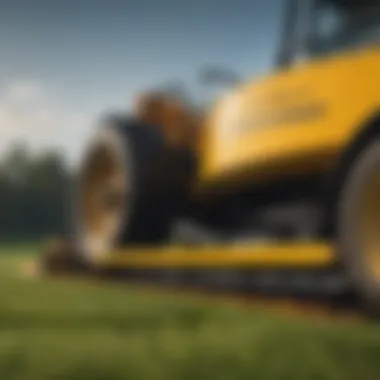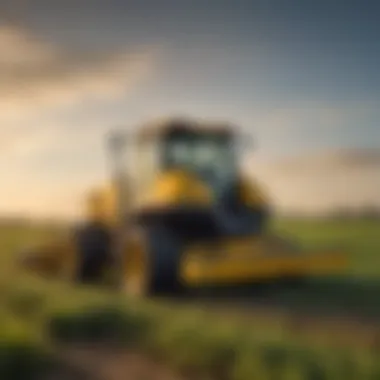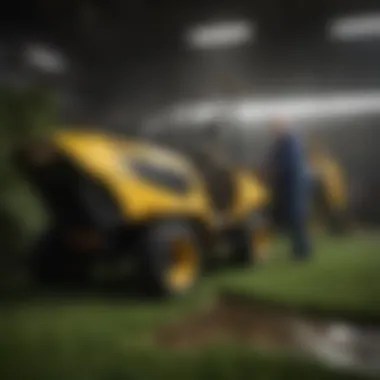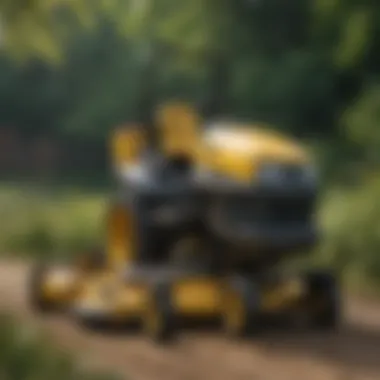Understanding the Vermeer Trailed Mower: Key Insights


Intro
The Vermeer Trailed Mower has positioned itself as a pivotal tool for modern farmers. As agricultural practices evolve, so do the tools used in these operations. This mower is designed to enhance mowing efficiency while also minimizing operational costs. Understanding its mechanics can greatly affect decision-making for individuals in agriculture.
Overview of the Topic
Definition and Importance
The Vermeer Trailed Mower is a type of machinery used primarily for cutting grass and hay. It has become increasingly significant due to its role in improving productivity on farms. Many farmers prefer it for its operational advantages over older equipment. This mower allows for faster cutting times, which is crucial for managing large areas of land effectively. Using advanced technologies, it can cut through thick grasses, ensuring uniformity in crop conditions.
Current Trends
Recent trends show a growing demand for efficient agricultural machinery. The introduction of precision farming has also influenced the design of mowers. Farmers now seek tools that integrate with GPS technology and data analytics. Innovations such as automated controls and enhanced safety features have made the Vermeer Trailed Mower a popular choice. Understanding these trends helps farmers make informed investments into their equipment.
Key Techniques and Practices
Step-by-Step Guide
- Preparation: Before using the mower, inspect it for any damages. This includes checking blades and hydraulic systems.
- Adjustment: Set the cutting height according to the type of grass and field condition. This can make a significant impact on the quality of the cut.
- Mowing: Begin mowing in an organized manner. Overlapping cuts can ensure a more complete job.
- Post-Operation Checks: After mowing, clean the machine to prevent rust and wear, and examine for any necessary repairs.
Tools and Equipment Needed
- Vermeer Trailed Mower
- Safety gear (gloves, goggles)
- Basic hand tools for maintenance
- Fuel and lubricant for operation
Challenges and Solutions
Common Obstacles
Farmers often face issues such as uneven terrain and varying grass types. This can affect mowing efficiency. Additionally, some may find difficulty in maintaining newer equipment like the Vermeer Trailed Mower.
Innovative Solutions
To combat these challenges, farmers can utilize terrain mapping technologies. Integrating these with the operation of the mower helps adapt to the field conditions. Moreover, engaging in regular training on advanced features can maximize the utility of the equipment.
"Despite the challenges, investing in a well-maintained mower can significantly boost productivity and operational efficiency in a competitive market."
Adopting the Vermeer Trailed Mower can lead farmers to improved practices. An understanding of its functions helps in achieving better results in the field.
Preface to Vermeer Trailed Mowers
The Vermeer Trailed Mower represents a pivotal advancement in agricultural machinery, emphasizing efficiency and adaptability. Understanding the features and functionality of these mowers is vital for farmers and agricultural professionals. With the growing demands of modern agriculture, it is essential to find equipment that can manage diverse mowing tasks while maximizing productivity.
Vermeer, a well-respected name in manufacturing, offers a rich assortment of agricultural equipment. Their expertise in creating durable and efficient machines is evident in the design of the Trailed Mower. This mower combines performance with ease of use, making it suitable for various farming needs. An exploration of the Vermeer Trailed Mower not only reveals its technical specifications but also highlights the benefits it brings to agricultural practices.
Overview of Vermeer as a Manufacturer
Vermeer is known for its commitment to craftsmanship and quality in agribusiness. Established in 1948 in Pella, Iowa, Vermeer has continually innovated in the field of agricultural machinery. This company stands out due to its focus on understanding the needs of farmers, leading to the development of practical and efficient mowers. Its reputation stems from a dedicated approach to performance and user feedback, ensuring that their machines not just meet, but often exceed, industry standards.
The Vermeer Trailed Mower is emblematic of the brand's values. Engineered with an emphasis on reliability and usability, it integrates advanced features that streamline mowing processes. Farmers can trust Vermeer to deliver equipment that is designed for real-world conditions, further solidifying the manufacturer's position as a leader in agricultural technology.
Historical Context of Trailed Mowing Equipment
The evolution of trailed mowing equipment illustrates significant shifts in agricultural practices. Initially, mowing was done manually, which was labor-intensive and time-consuming. The introduction of machines marked a turning point, greatly enhancing efficiency in large-scale farming.
The trailed mower was developed as a response to the need for higher productivity and versatility. Early models were rudimentary, but technological advancements have resulted in sophisticated designs, capable of handling varying mowing conditions. Today’s trailed mowers, including those by Vermeer, reflect years of innovation. Combining engineering expertise with agricultural know-how has resulted in machines that are more than just tools; they are integral to modern farming operations.
Understanding this historical context enhances appreciation for current designs. It demonstrates how far the industry has come and pinpoints the practices that have shaped present-day mowing technology.
Technical Specifications of Vermeer Trailed Mowers


Understanding the technical specifications of Vermeer Trailed Mowers is vital for farmers and agricultural enthusiasts alike. These specifications not only determine the functionality and efficiency of the mower but also offer insights into how well the equipment can adapt to various agricultural practices. Specifically, the engine power, cutting height, and gear mechanisms significantly impact performance, longevity, and user experience. By delving into these factors, users can make informed decisions that align with their operational needs.
Engine Power and Performance
The engine power of a Vermeer Trailed Mower is a crucial factor that influences its overall performance. Typically, these mowers are equipped with compact yet powerful engines designed for rugged use. This allows them to handle tough vegetation and extensive mowing tasks without compromising efficiency. A powerful engine can translate to higher cutting speeds, which is important during peak mowing seasons when time is of the essence.
Furthermore, robust engine performance helps in maintaining consistent cutting quality. The engine's torque and horsepower ratings are directly correlated with how well the mower can cut through dense or uneven terrains. Users often consider these specifications as they can directly affect fuel consumption, maintenance costs, and overall longevity of the equipment.
Cutting Width and Height Adjustability
The cutting width and height adjustability are fundamental features of Vermeer Trailed Mowers. A wider cutting width means that the mower can cover more ground in less time, enhancing productivity. For example, a cutting width of 10 feet allows for significant coverage, reducing the number of passes needed to complete a field.
Height adjustability is equally important. Adjusting the cutting height allows for flexibility depending on the terrain and the type of crop being mowed. Different plant types may require specific cutting heights; for instance, some grasses thrive when cut at a higher height. Moreover, the ability to make these adjustments easily can save time and labor, ensuring that operators do not need to stop frequently to modify settings.
Gear and Drive Mechanisms
The gear and drive mechanisms of Vermeer Trailed Mowers play a substantial role in their functionality and reliability. The quality of these components ensures that power from the engine transmits effectively to the cutting blades. The incorporation of a reliable drive mechanism can reduce slippage and improve mowing efficiency.
Vermeer utilizes advanced technology to create gear systems that provide optimal performance under varying conditions. These systems are designed for durability to handle the rigorous demands of agricultural mowing. Additionally, understanding how these gears work together allows users to maintain their equipment better and anticipate when parts might need replacement.
Overall, the technical specifications of Vermeer Trailed Mowers are not just numbers; they represent the essential qualities that make these machines suitable for modern agrarian challenges. By focusing on engine power, cutting width and height adjustability, and gear mechanisms, users can ensure they select a mower that meets their specific needs.
Operating Principles of the Trailed Mower
Operating principles are fundamental to understanding how the Vermeer Trailed Mower functions effectively in various agricultural settings. This section delves into the key components and functionalities that contribute to the mower's reliability and efficiency in performing mowing tasks. With proper knowledge of these operating principles, farmers can maximize the mower’s potential, enhance operational efficiency, and ultimately benefit from improved productivity.
Attachment and Hitching Mechanisms
The connection between a tractor and the Vermeer Trailed Mower is facilitated by its attachment and hitching mechanisms. These systems are essential for ensuring that the mower can operate smoothly while being pulled. The attachment system is designed to provide a secure linkage, allowing for easy connection and disconnection from the tractor.
Key aspects of attachment and hitching include:
- Versatility: The hitch can accommodate various tractor sizes and models, which makes it adaptable to different farming operations.
- Stability: A well-designed hitch ensures that the mower remains stable during operation, minimizing adjustments needed while mowing.
- Quick Release: The quick-release mechanisms save time, enabling farmers to switch tools as needed efficiently.
Overall, proper hitching techniques reduce wear and tear on the equipment, which leads to longer operational life.
Field and Terrain Adaptability
One of the standout features of the Vermeer Trailed Mower is its adaptability to different field conditions and terrains. This adaptability is critical, as it allows the mower to function optimally in diverse environments, such as hills, flatfields, and uneven ground.
Factors contributing to field and terrain adaptability:
- Adjustable Suspension: The mower’s suspension system can adjust based on the terrain, ensuring consistent performance on various surfaces.
- Wide Tire Dimensions: Larger tires can provide better traction on softer ground, reducing the likelihood of sinking or getting stuck.
- Mowing Height Adjustability: Operators can adjust the cutting height to suit the type of grass or crop being harvested, achieving optimal cutting results depending on specific conditions.
In essence, effective adaptability translates to enhanced mowing efficiency across distinct agricultural challenges.
Mowing Efficiency and Speed Considerations
Mowing efficiency is a crucial element in agricultural operations, as it directly influences productivity and time management. The Vermeer Trailed Mower is engineered to ensure optimal mowing speeds while maintaining cutting quality.
Several factors to consider include:
- Cutting Speed: Determining an effective cutting speed allows for a balance between productivity and the quality of cut. Slower speeds may provide better quality, but can reduce overall output.
- Width of Cut: The mower’s cutting width affects the number of passes needed to cover an area. Larger cutting widths generally lead to fewer passes, hence saving time.
- Blade Arrangement: The arrangement of cutting blades impacts the efficiency of the mowing process, allowing for more uniform cutting even at higher speeds.
Adopting optimal mowing speeds and techniques can enhance overall productivity while ensuring quality output.
"Understanding the operating principles of the Vermeer Trailed Mower enables farmers to leverage its features for maximized efficiency and better productivity in the fields."
Benefits of Using Vermeer Trailed Mowers
The Vermeer Trailed Mower presents numerous advantages that can significantly enhance the productivity and efficiency of farming operations. Understanding these benefits is essential for agricultural professionals looking to make informed decisions about their mowing equipment. As farming practices evolve, the need for effective machinery becomes more critical. The Vermeer Trailed Mower addresses these needs through its design and operational features. Below, we explore the key benefits that come with integrating this mower into agricultural practices.


Enhanced Cutting Performance
One of the most notable benefits of using Vermeer Trailed Mowers is their enhanced cutting performance. These mowers are engineered with advanced cutting mechanisms that ensure a clean and precise cut. This precision is vital when managing various grass types and densities, which can directly impact the quality of hay or pasture produced.
The blades are sharp and well-designed, allowing them to tackle tough vegetation without bogging down the machine. Furthermore, the cutting height adjustment features enable operators to customize settings for different conditions, ensuring optimal performance across diverse terrains. A well-maintained Vermeer Trailed Mower can achieve a consistent cut, resulting in uniform growth patterns and, ultimately, better forage quality.
Increased Productivity and Time Saving
Time is a valuable resource in agriculture. The Vermeer Trailed Mower enhances productivity by allowing operators to cover large areas in a shorter amount of time. Its powerful engine and efficient drive systems enable faster mowing speeds without sacrificing cut quality.
In addition, the ease of attachment and detachment simplifies operation for users. This allows farmers to quickly switch from mowing to other tasks, reducing downtime. The mower's large cutting width also contributes to increased output. This means that larger fields can be mowed in fewer passes, resulting in significant labor and time savings. Overall, the productivity advantages make the Vermeer Trailed Mower a strong asset on any farm.
Sustainability and Eco-Friendly Practices
As the agricultural sector increasingly emphasizes sustainability, choosing equipment with eco-friendly practices is vital. The Vermeer Trailed Mower is designed with energy efficiency in mind. Its engines are optimized for lower fuel consumption, which reduces greenhouse gas emissions compared to older models or less efficient mowers.
Moreover, maintaining healthy grasslands through proper mowing practices can enhance soil health and biodiversity. By ensuring a precise cutting height and promoting even regrowth, the mower supports the overall health of the plants and encourages pollinator activity. Using well-designed equipment like the Vermeer Trailed Mower contributes to sustainable agricultural practices, allowing farmers to balance productivity with environmental responsibility.
"Selecting the right equipment is crucial for effective farm management. The Vermeer Trailed Mower exemplifies how technology can improve performance while promoting eco-friendly practices."
Maintenance and Care of Vermeer Trailed Mowers
Maintaining and caring for Vermeer Trailed Mowers is crucial for ensuring their longevity, reliability, and optimal performance. Regular attention to maintenance helps prevent costly repairs and downtime, allowing agricultural operators to maximize productivity. Understanding the specific aspects that contribute to the upkeep of these machines can empower users to make informed decisions and enhance the efficiency of their mowing operations.
Regular Inspection and Troubleshooting
Regular inspection of Vermeer Trailed Mowers forms the backbone of effective maintenance strategies. Operators should conduct thorough visual checks before and after use to identify any potential issues. Key components such as blades, belts, and hydraulic systems should be carefully examined.
Troubleshooting should focus on:
- Blade Sharpness: Dull blades affect cutting efficiency and can lead to uneven mowing.
- Fluid Levels: Ensure hydraulic fluid, oil, and coolant levels are adequate to avoid overheating or mechanical failure.
- Hoses and Connections: Look for leaks or wear that can compromise operation.
Establishing a systematic approach to inspections can detect minor concerns before they escalate into major repairs.
"Regular maintenance is not an expense; it is an investment in long-term machine efficiency."
Parts Replacement Considerations
Parts replacement is an essential aspect of ongoing maintenance for Vermeer Trailed Mowers. Recognizing when to replace components can significantly affect the performance of the mower. Common replacement items include:
- Blades: Replace as needed based on wear. Dull blades lead to poor cutting quality.
- Belts: Inspect for frays or cracks and replace to maintain drive efficiency.
- Filters: Change oil and air filters as recommended to ensure optimal engine performance.
Opting for genuine Vermeer parts is recommended, as these components are designed specifically for compatibility and performance with the mower. Tracking hours of operation can help in planning timely replacements.
Cleaning and Storage Protocols
Proper cleaning and storage of Vermeer Trailed Mowers are often overlooked but are vital for maintaining their condition. After each use, some basic cleaning steps should be followed:
- Wash Down the Chassis: Remove grass, dirt, and debris to prevent corrosion and damage.
- Inspect Underneath: Ensure no debris is lodged under the mower to avoid blockages or fires.
- Lubricate Moving Parts: Apply lubrication to pivot points and bearings to ensure smooth operation.
When it comes to storage, keep the mower in a dry, sheltered area. Using a cover can protect it from the elements when not in use. Proper storage reduces wear and keeps the machinery in good condition for the next use.
Ultimately, prioritizing maintenance and care will lead to improved performance and a longer lifespan for Vermeer Trailed Mowers, enhancing their value in modern agricultural operations.
Comparative Analysis: Vermeer vs. Other Trailed Mowers
Understanding the comparative analysis of Vermeer Trailed Mowers against other models in the market is essential for farmers and agricultural enthusiasts. This section delves into how Vermeer stands out or faces challenges in relation to its competitors. We focus on several critical aspects: performance metrics, cost efficiencies, and user experiences. A comprehensive evaluation of these factors will allow potential buyers to make informed decisions based on concrete data and real-world feedback.
Performance Metrics against Competitors


When assessing performance metrics, Vermeer Trailed Mowers exhibit certain strengths that set them apart from competitors like Massey Ferguson and John Deere. One key area is cutting efficiency. Vermeer's design often includes wider cutting widths and advanced blade technology, enabling faster mowing of larger areas. This can translate to significant time savings in fieldwork, especially during peak seasons.
A crucial metric to consider is horsepower. Vermeer models typically feature powerful engines capable of handling tough conditions. This is particularly important for farmers operating in variable terrains, where power loss can significantly impede productivity.
- Cutting Width: Many Vermeer models boast a cutting width of over 10 feet, compared to 9 feet offered by many competitors.
- Horsepower: Higher horsepower not only offers better performance but also ensures longevity of the machine under heavy loads.
- Blade Designs: Vermeer often integrates innovative blade systems that improve cutting quality and reduce the need for frequent changes.
In practical terms, this means that Vermeer provides performance advantages for those looking to maximize their operational efficiency over sustained usage.
Cost Efficiency Comparisons
Cost is always a deciding factor in any equipment purchase. Analyzing the cost efficiency of Vermeer vs. other brands reveals constructive insights. While the initial investment for a Vermeer Trailed Mower can appear higher compared to alternatives, factors such as durability, maintenance costs, and fuel efficiency often lead to better long-term savings.
- Initial Cost vs. Longevity: Vermeer models are often designed for durability, reducing the need for frequent replacements or major repairs, which can be a hidden cost in cheaper models.
- Operational Costs: Vermeer typically ranks better in fuel efficiency, translating to lower running costs during operation.
- Resale Value: Mowers from Vermeer tend to hold their value well in the resale market, offering potential financial benefits in the future.
In summary, while upfront costs may be higher, Vermeer's overall cost efficiency can make it more favorable in the long run, especially for professional operators.
User Reviews and Testimonials
User testimonials contribute significantly to assessing any product’s real-world performance. Vermeer Trailed Mowers generally gather positive reviews from users across various platforms. These testimonials highlight the reliability, ease of operation, and quality cutting results achieved with Vermeer equipment.
"Upgrading to a Vermeer Trailed Mower has completely transformed my farming efficiency. The speed and agility surpass my previous brands!" - A satisfied farm manager
When comparing to competitors, users often praise the following aspects of Vermeer:
- User-Friendly Features: Many operators note the straightforward controls and ease of operation.
- Post-Sales Support: Users appreciate Vermeer's customer service and availability of replacement parts.
- Performance in Various Conditions: Farmers often share that Vermeer models perform well even in challenging conditions, a crucial factor when tending to diverse agricultural environments.
Overall, the user reviews provide an authentic glimpse into the functional advantages of choosing Vermeer, making them a compelling option for anyone considering a new trailedd mower.
Future Trends in Mowing Technology
The landscape of agriculture is constantly evolving, shaped by new technologies that increase efficiency and productivity. Understanding future trends in mowing technology is essential for farmers and agricultural professionals. This section delves into innovations, expected benefits, and considerations that come with these advancements. The aim is to shed light on how these trends can potentially enhance the capabilities of equipment like the Vermeer Trailed Mower.
Emerging Technologies in Agricultural Equipment
Emerging technologies in agricultural equipment play a pivotal role in improving operational efficiency. Manufacturers are integrating features like GPS, advanced sensors, and data analytics into mowing devices. These technologies allow for precise mowing and improved decision-making. For instance, smart mowing systems can gauge grass density and adjust cutting height automatically. This means less waste and a faster job with better-quality results.
In addition, robotics and drones are beginning to find their place in mowing. While still in the early stages, autonomous mowers have the potential to operate without direct human intervention. They can work during off-peak hours, minimizing the disruptions typically associated with traditional mowing methods. Furthermore, the integration of IoT (Internet of Things) allows equipment to communicate with other machines, optimizing overall farm operations.
Impact of Automation on Mowing Practices
Automation is changing the way mowing is approached within the sector. With automated mowers, farmers can allocate resources more efficiently. These machines can work for extended periods, even in their absence. This shift could address labor shortages that many farms face.
Moreover, automated equipment often reduces the likelihood of human error. By using data gathered from previous performances, these mowers can execute tasks with high precision. This needle-sharp focus on accuracy helps to minimize the risk of over-mowing or missing patches, thus enhancing overall productivity.
It's also important to consider that automation does come with challenges. Investment costs can be substantial, particularly for farmers with budget constraints. Additionally, operators will need training to manage and troubleshoot these advanced machines efficiently.
To conclude, while advancements in mowing technology present an array of benefits, understanding and preparing for the challenges is equally vital. Keeping abreast of these trends will allow agricultural professionals to apply the most effective strategies in their operations.
End and Recommendations
The importance of the conclusion and recommendations section cannot be overstated. It synthesizes the critical insights presented throughout the article and articulates the significance of the Vermeer Trailed Mower in modern agricultural practices. This section acts as the final interpretative layer, bringing clarity and direction to the analysis that precedes it.
Summation of Key Findings
In reviewing the Vermeer Trailed Mower, several key findings emerge:
- Technological Superiority: The Vermeer Trailed Mower showcases innovative engineering, particularly in its cutting mechanisms and adjustable height settings. This leads to enhanced performance under diverse conditions.
- Maintenance Considerations: Regular checks and proper care are essential. Timely maintenance reduces breakdowns, ensuring efficient operation during peak periods.
- Comparative Advantage: When compared to competitors, Vermeer Trailed Mowers often yield superior performance metrics, providing a stronger return on investment.
- Sustainability Focus: The design also supports sustainable farming practices, contributing to the efficient use of resources while minimizing environmental impact.
These findings underscore the value of integrating the Vermeer Trailed Mower into agricultural workflows, especially for those focused on productivity and sustainability.
Practical Tips for Implementation
Here are several practical tips to facilitate successful implementation of Vermeer Trailed Mowers into your operations:
- Training Operators: Ensure that operators receive sufficient training on the machine’s features to maximize its potential. Understanding the operational principles enhances safety and efficiency.
- Scheduled Maintenance: Establish a consistent maintenance schedule to regularly check oil levels, blade sharpness, and overall functionality. This helps in identifying issues before they escalate into costly repairs.
- Field Trials: Conduct field trials to understand the mower's performance in your specific conditions. Collect data regarding cutting efficiency and time, which can inform future operational strategies.
- Community Engagement: Engage with other farmers or join forums on platforms like Reddit, where experiences with Vermeer products are shared. This can provide valuable insights and tips for troubleshooting common issues.
Implementing these tips can optimize the user experience and amplify the benefits derived from using Vermeer Trailed Mowers. With proper understanding and care, these machines can significantly enhance productivity in agricultural operations.



